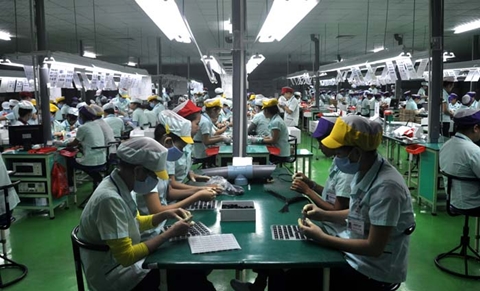Sources of electronic component wastewater
Wastewater from the production process: contains many heavy metals, chemicals, and impurities;
Domestic wastewater: generated from kitchens and restrooms of employees. This wastewater contains many organic substances, microorganisms, and grease.
Characteristics and properties of electronic component wastewater
Electronic components manufacturing industry wastewater mainly consists of inorganic components. For example: metals, impurities, chemicals, suspended sediments and organic components, bacteria…
Electronic component wastewater treatment technology
Electronic component wastewater treatment technology
Explanation of technology diagram
Step 1
All wastewater generated from the production process is directed to the collection tank. Large-sized waste is retained by trash screens and then processed.
Step 2
Water is pumped from the collection tank to the regulation tank to stabilize the concentration and flow. Then it is sent to the reaction tank.
In the reaction tank, there is an automatic pH measuring device (pH controller) and automatically controls one of two chemical dosing pumps to balance the wastewater pH according to the pre-set pH index at the pH controller.
The purpose of adjusting pH in wastewater is to increase the treatment efficiency of chemical treatment and save chemicals used in the treatment process.
After stabilizing the pH, the water is transferred to the flocculation tank. A flocculation aid (PAC, or alum) is diluted into a chemical container. And the chemicals are pumped quantitatively into the flocculation tank.
To mix the flocculation chemicals and wastewater evenly, a stirring motor and paddle are installed in the tank to mix the wastewater with the flocculation chemicals. After being mixed with chemicals, the wastewater will overflow into the flocculation tank to continue the treatment process.
Step 3
At the flocculation tank, the flocculating chemical (polymer) is diluted into a chemical tank and pumped into the flocculating tank.
To mix the flocculating chemicals and wastewater evenly, a stirring motor and paddle are installed in the tank to mix the wastewater with the flocculating chemicals.
Polymer chemicals are responsible for binding small suspended flocs together to form larger sludge flocs capable of settling by gravity.
Step 4
After being mixed with chemicals, the wastewater continues to flow into settling tank 1 to settle the sludge flocs.
In the settling tank, under the influence of gravity, the sludge flocs settle to the bottom of the settling tank. The sludge separation water is collected in the collection trough above. Then transfer to Aerotank biological treatment tank.
The sludge in the settling tank is pumped to the sludge tank and treated.
Step 5
Aerotank has the effect of treating organic substances thanks to aerobic microorganisms under conditions of continuous oxygen supply.
After biological treatment, water is sent to settling tank 2 to settle the activated sludge formed from the aerotank.
The treated water is transferred to a disinfection tank to remove harmful microorganisms before being discharged into the environment.
The partially settled sludge is circulated to the aerotank. The remaining sludge is sent to the sludge tank for treatment.
Standards for Electronic component wastewater treatment output
After treating electronic component production wastewater, it must meet QCVN 40: 2011/ BTNMT, National technical regulation on industrial wastewater.
Advantages and disadvantages of electronic component wastewater treatment
- High treatment efficiency, meeting regulatory standards;
- Reasonable processing costs, savings for businesses;
- Short construction and installation time.
- The treatment process creates sludge that needs to be treated.


